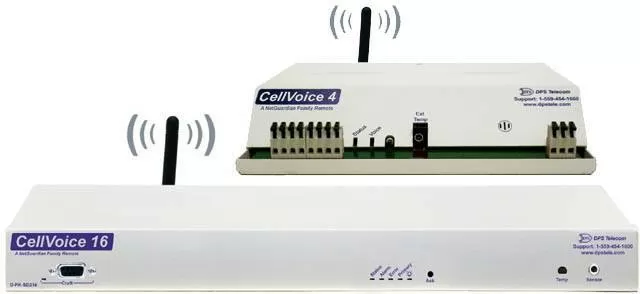Check out our White Paper Series!
A complete library of helpful advice and survival guides for every aspect of system monitoring and control.
1-800-693-0351
Have a specific question? Ask our team of expert engineers and get a specific answer!
Sign up for the next DPS Factory Training!

Whether you're new to our equipment or you've used it for years, DPS factory training is the best way to get more from your monitoring.
Reserve Your Seat TodayGot a question after watching? Want more CellVoice information? Send Mac a message below
Hello again. This is Andrew from DPS TV, and today I'm outside near a cell tower. As you know, cell towers are used to make phone calls. But did you also know that you can get voice alerts about your network alarms via the network of GSM/CDMA cell towers?
Today, I want to talk to you about 2 new DPS RTU's that have cell antennas on the back of them (both are part of the NetGuardian family of remotes):

When you have an important alarm, these remotes generate a custom voice message, and then send it out to the cell tower so it can then reach your phone (cell phone or landline).
Today, I've got the DPS Telecom Engineering Department standing by to answer my questions, so let's get to it. I interviewed Mark, DPS Director of Engineering about the CellVoice 16 and CellVoice 4 RTUs:
Mark, why have the cellular and voice technologies now been combined in the NetGuardian RTU family?
Well, it made sense to do so. We had both technologies. We had RTUs that can use dial-up to give you voice notifications, and we also had GSM/CDMA wireless technology on other RTUs. So it made sense that we would have a wireless/cellular product that could make a voice call to your cell phone or any other telephone.
[Watch video to hear CellVoice sample voice message]
For viewers who aren't familiar with the existing NetGuardian voice products, how do you configure the voice alerts and other properties on these NetGuardians?
That's a great question. We have a very easy-to-use utility. It's a Windows®-based utility, and it will enable you to configure your alarm points with various text - just as you normally would. You can see that text when monitoring the RTU via web browser interface, but also that text is used with text-to-speech technology. The software connects to the DPS Telecom website and it's a one-click download to convert all of your text strings into actual voice. That's what gets stored on the CellVoice remote so, if an alarm occurs, it knows what to say when you get called.
So, does that mean that you have an empty text field for voice alerts and you can type pretty much whatever you want?
Absolutely. It's very, very configurable and it's not just for the alarm descriptions, but also things like severity that could be associated with your alarms. You get all of that information when you get a phone call from a CellVoice RTU.
Let's say we've got someone configured to receive voice alerts on their phone, but it's the middle of the night and they're not answering their phone. What happens then?
We support lots of different configuration options for call lists. You can create more than one call list if you need to. Let's say the first person doesn't answer. You can configure the device so it will make a phone call to another person, and it will keep going down the call list until it gets an acknowledgment. Let's say there's no acknowledgement and nobody answers, there are other ways that the CellVoice can notify your team that there's a problem.
That's interesting. Tell me more about combinations of notification methods.
Well, the product can have a wireless GSM/CDMA interface, and it can also have a dial-up POTS interface. Let's say that, for whatever reason, it isn't able to call through the dial-up interface, it can use the wireless connection as a backup. This helps you avoid cellular charges when a dial-up phone line is available.
I know that most NetGuardian RTUs also send out SNMP over LAN. Will these CellVoice RTUs also have that interface?
Absolutely. If you buy it with LAN, you can web browse to it and it can certainly do SNMP also.
Watch the full video above to hear more OR ask Mac Smith a question using the quick form below
To receive a price quote or ROI analysis...
Call 1-800-693-0351